Ryan Hall's Blog, page 156
June 22, 2017
Meet New York’s Ultra Tough Guy Who Runs an Ultra a Month
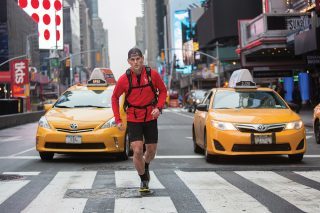
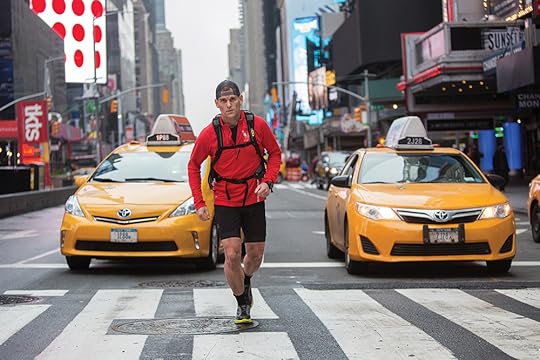
Photo: Daniel Weiss
Chris Rice, 6’1” and 188 pounds, is the kind of guy you might meet sipping his morning coffee and reading The Wall Street Journal on the 6:22 commuter train from Suffern, N.Y., for the hour-plus trip to a banking institution in Manhattan, where he’s a development manager in technology. But Rice doesn’t take the train. Instead, he parks near the George Washington Bridge and runs 10 miles most mornings to his office—or, rather, to a gym, where he stores 10 business suits and gets his running laundry done.
Rice’s logistical weekday wizardry—he actually has two offices, one in Jersey City, and uses two gyms—involves multiple clothing changes, running through rush-hour traffic, bicycling, and CrossFit workouts along with swimming and full-court basketball, and an occasional subway ride for connections. Somewhere in that byzantine schedule, Rice does another 10 miles of running per week, so that from Monday to Friday, he logs about 60 miles, adding another 15 or so on weekends.
In mastering this system, Rice, 43, can usually be home for dinner with his wife, Patty, and their three sons— Peyton, 16 ; Teague, 14; and Asher,9—and try to be a regular dad who barbecues in the burbs on weekends.
“It goes family first, then work, then athletics,” says Rice. “If I have a conflict between work and running, work wins. But sleep might suffer.”
If work wins and Rice can’t get in all his weekday mileage, he might meet an ultra-running friend at midnight on a Friday (that is, Saturday morning) and run nonstop through the night until 5 a.m. on the Appalachian Trail with a headlamp and flashlight. How does that after-hours duty go down with Patty? “She’s fine with it,” says Chris.
Running five hours through the night adds to Rice’s reservoir of toughness, which he considers his calling card. Since 1999, he has done almost 200 ultras and adventure events—averaging about one a month—specializing in events of 100 miles and up and multi-day races. Rice’s prolific achievements fly in the face of recovery-time doctrine, defying what the body goes through when taken to the limit.
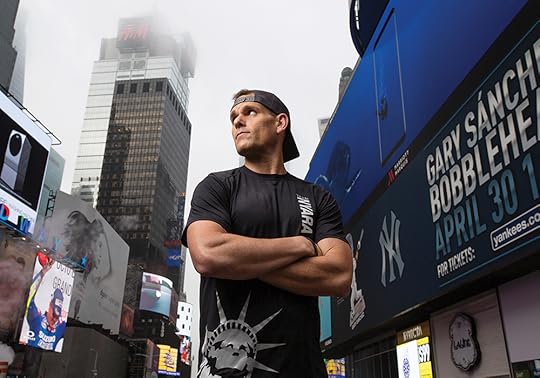
Photo: Daniel Weiss
Even the best ultra-runners need a break. How does Rice, who’s won a number of major events, deal with the body’s inevitable breakdown in a 100-miler when he’s got another 100, or maybe a 72-hour adventure contest, coming up only a month later?
“I ignore it,” Rice says of whatever cry emerges from his ravaged body. He adds, in defense of the non-scientific method, “I don’t do V02 max. I don’t pay attention to what I’m eating during races. I don’t carry fluids. Other people might out-science me, but I try to out-tough them.”
Rice’s latest opportunity to test his toughness was on June 17 at the Great New York 100 Mile Running Exposition, which starts and finishes in Times Square and travels through just about every park and ethnic neighborhood in the outer boroughs. Rice placed fourth in 2013 and fifth in 2014. Only a few competitors complete the route in less than 20 hours.
RELATED: 6 Everyday Runners’ Secrets To Survival And Success
As usual, Rice will take the line at 5 a.m. with no elaborate fuel-replacement strategy, no tinkered-with running shoes, no mind-body practice to guide him, no coaching wisdom or biblical mantras, and feel quite chipper despite a serious lack of sleep.
Rice relies on a high pain threshold, which he feels comes from his father, a West Point man who saw action in Vietnam. “Success,” says Rice, “depends on two things—a high level of patience and high level of pain tolerance. The older I get, the more pain I can endure.”
In his adventures, Rice savors both the pain and rhapsody that he longs to experience again and again. “As soon as I finish one race,” he says, “it’s like an addiction. I need to have the next one coming up.”
Rice can’t let go because he feels there’s too much at stake: the opportunity to accomplish something few people can and, as he puts it, “cannot be taken away. I’ve done it. It’s mine.”
Just about anyone can run a marathon—these days it’s as much of a happening as a sport. Why join the masses running 26 miles when you can link with like-minded people running four times as long and experience the transcendence of what Rice calls “being out there” in a different world. He says that while racing hours upon hours in an ultra, “I’m blank and there’s clarity. It’s like meditating. There’s no stress. I have a singular focus of finishing.”
In the New York 100, Rice says he most anticipated the “surreal weirdness” of the 80-mile point when he emerged from the solitude of his internal rhythms and onto the splashy Coney Island boardwalk packed with Saturday night revelers and, as he says, “Brooklyn hipsters.” While Rice finds the contrast jarring, it’s a moment he treasures: an elusive taste of a cultural touchpoint while he’s at his most vulnerable.
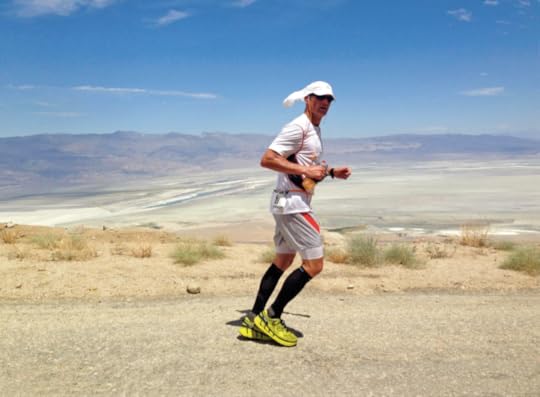
In 2014, Rice ran the Badwater 135, placing 25th out of 100 starters.
The revelry and smell of the sea carry Rice onward, but it’s not his most precious race experience of all. That one occurs hours from any drop of water, in Death Valley, Calif., in the struggle to complete the 135 miles of the notorious Badwater. Rice did Badwater—“the hardest race on the planet,” he says— in 2014, placing 25th out of 100 starters. And he did it one month after the New York 100, which followed three ultras, including the New Jersey 100, in the previous four months.
“In Badwater,” says Rice, “you’re basically racing foot pain. With the massive heat, your feet are constantly wet from sweat. You can see 30 miles in front of you. You have to calm your mind. You keep asking yourself, ‘Can I make it to the end before my feet just give in?’” Rice completed the 2014 race in 34 hours and 21 minutes.
Before Badwater, Rice trained about 100 miles a week but did not do long runs of even 20 miles or more, standard for regular marathoners going a mere 26.2 miles. Rice uses his monthly ultra races as training, figuring that each long event functions as training for the next one. Admitting that his approach may seem counterintuitive, he says that constant activity aids recovery and prepares him for the next event all at once.
RELATED: 8 Tough Workouts for Tough Runners
Rice’s claim of increasing pain tolerance bears out in a string of recent victories. Last July in extreme heat—temperatures in the 80s and humidity in the 90s—Rice won the Viaduct Trail 100 Miler in the northeast Pennsylvania wilderness by more than an hour. This past January, in a snowstorm, Rice won the Watchung 50K in New Jersey by more than 9 minutes. “I like adverse weather,” he says.
Rice’s first 100, in 2010, about a decade after his first ultra, came after adversity that would have overwhelmed lesser athletes. In 2009, as a result of back surgery, Rice contracted a rare, life-threatening staph infection in his spinal column that required a second emergency operation for spinal fusion. Within 24 hours following the second surgery, Rice was walking laps around the hospital corridors. But he’d lost months of training, had 14 inches of staples in his back and had to be on antibiotics for a year.
Once the staples were removed, Rice could run but would have a permanent “cage” in his lower back consisting of bolted titanium rods. Even in his weakened state, Rice chose a predicable route to get back in shape: By embarking on his first 100.
What about the contraption imbedded in his back? “I don’t even think about it,” he says. Twelve months after the surgery, Rice did the New Jersey 100, now called the New Jersey Ultra Festival, and was on his way
Rice has no residual back problems, but he also has a plate and ten screws in his right hand after falling during a 25-mile trail run near his home. “I try not to think about that either,” he says.
The episode weakened Rice’s right-hand grip, an impediment for him in Spartan and Tough Mudder events that require climbing ropes and walls. Rice also uses his hands in adventure races that typically include canoeing and mountain biking along with running (in a trekking or orienteering way) for 24, 48 or 72 hours, sleep be damned. Rice competes in these events individually or as part of a team. (In team competition, each member must complete all disciplines.)
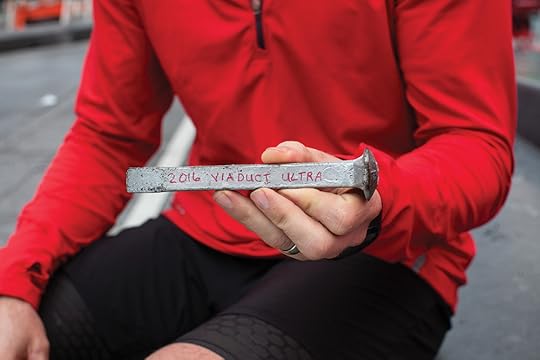
The kinds of races Rice runs in sometimes offers unusual rewards in place of medals, like this spike for the Viaduct Trail Ultramarathon. Photo: Daniel Weiss
In one Spartan Death Race, a 48-hour event in Vermont, Rice’s four-man team was victorious. The challenges included running up and down a mountain hauling a 70-pound sandbag in your backpack. And on virtually no sleep either, or the opposition would get ahead. “I popped caffeine pills,” Rice says.
In his most recent adventure event—the 72-hour Florida Sea to Sea race in March—Rice and a partner, Bruce Swanson, 53, took fourth in the overall two-man team competition. Traveling via land, water and wheels from the state’s east coast near Daytona Beach to its west coast at Crystal Springs, the pair took 66 hours, 54 minutes to navigate the backwoods crossing. They did get a bit of sleep—there was a mandatory “dark zone.”
Rice holds that just about anyone can find his ultra “soul” by shedding perceived limits. “People have a mental map that sets borders, that says, ‘This is the edge of your reality,’” Rice says. “Every time you do something you didn’t think you could do, you redefine that border.”
One time, in a four-day, 250-mile event with the finish nearing, Rice almost had to alter the borders of the race course. In a contest of trekking, mountain biking, rappelling and navigating unmarked terrain in the Appalachian Extreme in Maine and New Hampshire, Rice and his teammates emerged from a night of racing through the woods and into the daylight when Rice encountered something that nearly scared the life out of him.
“A moose,” he says. “You don’t know how big a moose is until he’s right in front of you. The sun had just come up and he’s staring at me, with smoke coming out of his nose.”
But the moose must have seen something that impressed him. Before Rice could find a way to retreat, the moose ran away.
The post Meet New York’s Ultra Tough Guy Who Runs an Ultra a Month appeared first on Competitor.com.
Why Your Weight May Be a Factor When Choosing a Running Shoe
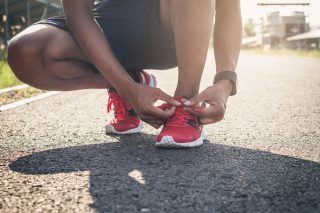
If you’ve been to a specialty running store, you probably know there are a lot of considerations when choosing a running shoe, from your gait to your arch position and more. However, according to a recent study, you may want to factor in your weight, as well.
Researchers at the University of South Australia’s Sansom Institute for Health Research used 61 trained runners and followed them over the course of 26 weeks.
They found that runners weighing over 85 kilograms (187 pounds) and trained in a lightweight running shoe “were over three times more likely to sustain an injury than when wearing conventional running shoes.” Runners who weighed less than 71 kilograms (156 pounds) benefitted from lightweight shoes and did not see any impacts on their injury risk.
RELATED: Are Shoes Really to Blame for Running Injuries?
“Minimalist shoes do have an appeal to runners and as they can help you run faster, but heavier runners should think twice about using them because they can increase the risk of injury,” says Professor Jon Buckley, co-researcher and Director of UniSA’s Alliance for Research in Exercise, Nutrition and Activity (ARENA). “Weight produces higher impact forces that increase injury, regardless if this is the result of being a taller and possibly heavier person, or a person carrying a little more weight than average. So it’s not the BMI to be concerned about, it’s the actual weight.”
Knowing your shoe lingo and asking about the heel-to-toe drop and midsole may help you get the proper stability and cushioning for not only your foot type, but also your body type, in order to prevent injury.
RELATED: Safely Transitioning To A Minimalist Running Shoe
The post Why Your Weight May Be a Factor When Choosing a Running Shoe appeared first on Competitor.com.
5 Things To Watch At The USATF Outdoor Championships
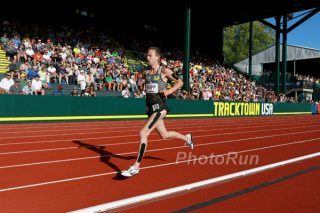
Photo: photorun.net
The 2017 USA Track and Field Outdoor Championships begin today in Sacramento, Calif. From June 22-25, the best runners in the country will be vying for a chance to head to the IAAF World Championships in London later this summer. A top three finish in each event secures an athlete’s place on the world team. But the competition is tough and the weather won’t make it any easier. Thursday’s high temperature in Sacramento is expected to reach 107 degrees and won’t fall below 95 all weekend.
Here are the events and runners you should watch for—and where you can see all the action.
How To Watch
TV coverage will be split between NBC and NBCSN. On Friday, NBCSN will show the meet from 10:30 p.m. until 12:30 a.m. ET. On Saturday and Sunday, NBC will provide coverage from 4:00 p.m. to 6:00 p.m. ET on both days. NBC Sports Gold will provide a continuous stream for online viewers from Thursday through Sunday. However, it is a subscription based service, available for $69.99 for the entire track and field season. Get the meet schedule here, but note that times may change due to the weather.
Gabe Grunewald Will Race 1500 Meters While Fighting Cancer
The most inspiring runner at USA Nationals might be Gabe Grunewald. The 31-year-old runner is currently battling cancer for a 4th time in 8 years. On June 4 she began chemotherapy to treat adenoid cystic carcinoma, a form of cancer in the salivary gland that has spread to her liver. Despite undergoing treatment, Grunewald continued to race towards the meet standard and was accepted into the meet, despite falling just short. USATF Championships fall during a 2-week break in chemo for Grunewald, giving her a bit of added strength. While it is probably a long shot for Grunewald to make the London team, her strength and competitiveness should not be counted out. Watch for her in the first round of the 1500 meters on Thursday at 12:05 a.m. ET. The race includes three Olympians who are expected to make the world team: Shannon Rowbury, Jenny Simpson, and Kate Grace.
Olympic Marathoners Rupp and Flanagan Hit The Track
The top U.S. marathoners are back to race the 10,000 meters on the track. On the men’s side, Galen Rupp is the favorite to win his ninth consecutive national title in the 10K. Rupp has been focusing on longer road events, coming off a 2nd place finish at the Boston Marathon this past April. This could possibly be the last track 10K he runs in the U.S. In the women’s race, Shalane Flanagan continues to make her way back from a fracture in her back. While she has only run one 10K this year, she easily nabbed the World A standard. Challenging Flanagan for a chance to race in London are her training partner Amy Cragg, American 10K record holder Molly Huddle and Olympian Emily Infeld. Both the men’s and women’s 10K’s take place Thursday night/Friday morning (depending on the time zone). Women start at 12:27 a.m. ET and the men start at 1:09 a.m. ET.
RELATED: Olympian Emma Coburn Is Aiming For Sixth USA Steeplechase Title
Alysia Montaño To Race While Pregnant
Once again, Alysia Montaño is returning to run the 800 meters—and once again, she will run the race pregnant. Back in 2014, Montaño became a viral sensation when she raced at USATF Championships while 8 months pregnant with her daughter Linnea. Montaño’s second child is due in November. As for the rest of the field, 1500-meter Olympian Brenda Martinez is the favorite going into the race. Martinez has stated that this is her last season focusing on the 800, with plans to move up in distance next season. The first round of the 800 meters starts at 8:25 p.m. ET on Thursday.
Murphy Will Attempt 800/1500 Double
Olympian Clayton Murphy has his sights set on winning both the 800 meters and 1500 meters. The last time this was done was 1933. So far he is the clear favorite for the 800. His biggest threat in that race is Donavan Brazier, whose 1:44.43 ranks #3 in the world this year. However, the biggest threat to double gold comes when he faces Olympic gold medalist Matt Centrowitz in the 1500. Centrowitz has only raced three times this season, but his only 1500m was a win over Mo Farah in a fast 3:33. First round of the men’s 800 is Thursday at 8:00 p.m. ET, while the first round of the 1500 is at 11:44 p.m. ET.
Double Amputee To Compete In The 400 Meter
Blake Leeper will race the 400-meter qualifying heats on Thursday night at 10:00 p.m. ET. According to NBC Sports, the USATF could not recall a double amputee previously competing in the Outdoor Championships. Leeper was suspended for 2 years after testing positive for cocaine in 2015. Prior to his suspension, he earned a silver medal in the 400m and a bronze in the 200m at the 2012 London Paralympics.
The post 5 Things To Watch At The USATF Outdoor Championships appeared first on Competitor.com.
Should Runners Know Their Race Course or Is Ignorance Bliss?
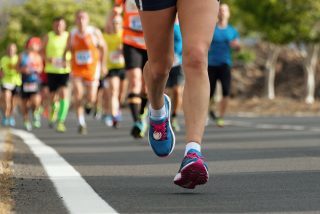
There are two types of runners in this world: those who know their race route and those who don’t. When you step up to the start line, many runners prefer to know exactly what they are in for. Others would rather be surprised. Let’s consider the benefits and risks of course knowledge for the following distances:
5K
If you know the course, you can’t go the wrong way, right? Nope. Getting lost in the middle of a 5K happens more often than you think, especially at shorter and smaller local races that may not have as many volunteers or signs. It happened to me when I followed a lead pack of high school boys, only to find out we missed a very small sign indicating the turnaround. We all ended up running almost an additional mile. It also cost me the win.
Lesson: It’s not always wise to just “follow the leader.”
RELATED: 10 Things That Could Go Wrong On Race Day
Half Marathon
Don’t you want to know what those hills look like? They are usually the biggest concern in almost any race. But hills can mean different things to different runners. The placement of the hills on the course is usually more concerning than the actual hill itself. A half marathon is a significant distance—even if you don’t run for the entire 13.1 miles, you may want to at least drive the course so that you know what to expect.
Lesson: Don’t fear the course—own it! Give yourself the power of knowledge before you step to the start line.
Full Marathon
It’s all about those last six miles and I always suggest running that part of the course. This served two purposes:
1. Mile 20 is usually where you hit the wall. It’s nice to already have some kind of memory of those last six miles, since your brain may start to check out at this point during the race.
2. I want the runner to have a gorgeous visual of running those last six miles strong. It’s important to actually see what the finish area looks like. That way, he or she can conjure up that vision throughout the 26.2 journey on race day.
Lesson: Things can get ugly in those last six miles. Your mental preparation may be the only thing to get you to the finish.
RELATED: The Keys To Running With Mental Toughness
The post Should Runners Know Their Race Course or Is Ignorance Bliss? appeared first on Competitor.com.
June 21, 2017
Olympian Emma Coburn Is Aiming For Sixth USA Steeplechase Title
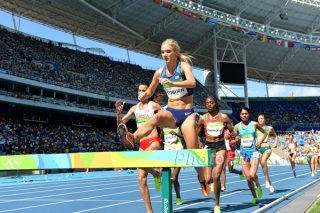
Emma Coburn won the bronze medal in the 3,000m steeplechase at the 2016 Olympics in Rio. Photo: Photorun.net
(c) 2017 Race Results Weekly, all rights reserved
The last time the USATF National Outdoor Track & Field Championships were held at Sacramento State University in California, the women’s steeplechase final was contested on a Saturday afternoon. The sun was blazing, and the temperature was 91°F when the 14 women who competed answered the starter’s gun.
Nonetheless, Emma Coburn of Boulder, Colo., boldly ran away from the field setting a quick pace. She clocked a championships record of 9:19.72, beating her nearest competitor by eight seconds, and bagged what was then her third national steeplechase title (she now has five).
Is Coburn, who runs for Team New Balance, a gifted hot weather runner?
“I hate the heat,” Coburn told reporters at a press conference, the day before running in her preliminary heat. “I grew up in the mountains. I love 60 degrees. If I can be in shorts and a long sleeve, that’s ideal.”
Thus, for the 26-year-old Coburn, who grew up in Crested Butte, Colo., tomorrow’s conditions will be much less than ideal, despite the fact that USA Track & Field officials have pushed back today’s nighttime program by a full hour to help athletes avoid the worst temperatures. Nonetheless, after a projected temperature of 96°F at the time of her race at 8:13 p.m., Coburn said she will be ready, taking precautions like wearing an ice vest and staying hydrated.
“I have had many experiences racing in the heat, flashing back to collegiate racing in the Regionals in Austin, Texas,” said Coburn, recalling her days as a student-athlete at the University of Colorado. She added, “As long as I prepare well… I can do pretty well.”
Coburn, who won a bronze medal at the Rio Olympics and holds the USA record of 9:07.63, may well be the #1 favorite at these championships to retain her title. She’s competed sparingly this year, only running two steeples, but both have been fast. She clocked 9:14.53 at the Doha Diamond League meeting on May 5 in her season opener, then came very close to her national record at the Prefontaine Classic on May 26, clocking 9:07.96. She feels that she is rounding into shape on the right schedule, and will be prepared to run faster later this summer.
“I usually open up around Pre and USA’s some years,” Coburn explained. “I feel like I’ve been the fittest I’ve ever been at this point in the year.”
This is Coburn’s first season training along side Jamaican steepler Aisha Praught-Leer and under the coaching direction of her fiancé, Joe Bosshard. Bosshard, who was Coburn’s teammate at the University of Colorado, took over from Coburn’s longtime and college coaches Mark Wetmore and Heather Burroughs, a transition which Coburn said has gone smoothly and has felt very natural.
“Mark and Heather got me to where I was and were a big part of my life for eight years,” Coburn told Race Results Weekly. “I wasn’t seeking out a coaching change, but it worked out to be that way. Joe, I wasn’t looking for him to be my coach at all, but he was kind of in this space where I needed someone and thought, well, let’s try it for a short time… and see how it goes.” She added, “It’s been going really well.”
Despite being heavily favored to win here, Coburn said she won’t be taking a relaxed attitude towards the race. With 28 barriers and seven water jumps to clear, she can’t afford to lose focus.
“The steeplechase is a wonderful event and a horrible event,” Coburn quipped. “Because of the barriers anything can happen. That keeps me guarded; that keeps me focused on the task at hand.”
RELATED: Emma Coburn Talks Steeplechase
The post Olympian Emma Coburn Is Aiming For Sixth USA Steeplechase Title appeared first on Competitor.com.
New Study Found Sexist Coverage Of Female Athletes Increased During 2016 Olympics

Anecdotally there seems to be no shortage of sexist remarks made in the media about successful female athletes. However, two researchers at the University of Missouri wanted to quantify instances of what they’ve classified these types of remarks as “microaggressions,” specifically with regards to Olympians.
In a new study, Cynthia Frisby, associate professor of strategic communications at University of Missouri, along with her undergraduate student Kara Allen, analyzed 732 newspaper and magazine articles to understand the coverage of female athletes during the 2012 and 2016 Olympics.
They cataloged instances of microaggressions, which are comments made in regards to a person’s race and gender. These comments often have the consequence of belittling the athletic accomplishments of women. The researchers wanted to find “how images…are portrayed in media and how they can be used to create a stereotype, sustain them or make them stronger,” according to Frisby. They focused on seven Olympic sports: gymnastics, tennis, track and field, weightlifting, basketball, swimming and beach volleyball.
In total, microaggressions increased by 40 percent from the 2012 to the 2016 Olympics. Of the 165 instances of microaggressions found in print coverage, 96 of them were during the 2016 Games.
Looking specifically at track and field athletes, 33 instances of microaggressions were recorded. The only sport that had more was gymnastics. Some coverage attributed the success of a female track and field athlete to a man. Others used racist and sexist language, focused on the athlete’s body type or were sexually objective in tone.
“We have sports that are considered more gender appropriate. Gymnastics might be considered more feminine,” says Frisby. “Track and field comes up in the research as being a gender-neutral sport.”
Despite the perception that track and field is a sport for both genders, there was still many instances of objectification around women’s bodies.
RELATED: Don’t Let Body Shamers Keep You From Running Like a Boss
“We found that female athletes were written about in a number of different ways in terms of their attractiveness, mostly their bodies,” says Frisby. “Women who are toned and extremely muscular are perceived to be masculine because women aren’t supposed to have muscles. Some of the comments were about how pretty the person is when they were supposed to be a story not on how pretty they were but that they just won a gold medal.”
Frisby also notes that many female athletes are often compared to male counterparts instead of being celebrated for their own accomplishments. She uses Simone Biles as an example. There were instances of Biles being called the “female Michael Jordan.” While these comparisons are often made by journalists to help those unfamiliar with the Olympic sport, it takes away from a female Olympian’s success.
“The biggest problem is when you make those comparisons is that you might unintentionally create and maintain stereotypes,” Frisby says. “So what if someone doesn’t know who Simone Biles is. What impression are they going to get once you have made that comparison?
“To me it makes a subtle inference that your audience is so dumb that they can’t understand and read the material. Most journalists make an assumption that the audience needs those comparisons to understand something not familiar to them.”
Even though the study focused on print media, Frisby says that sexist commentary was also made during TV broadcast, “but print media would pick them up as well and do stories about them.”
Frisby shared that the reaction to the study has been enlightening. Some journalists are appreciative of the research, while others are having a tough time believing the data. However, she has received emails from male journalists who have admitted to struggling with how to frame the accomplishments of female athletes.
“Those are the instances when I feel like my work has made the most impact,” Frisby says. “When we can at least get the data out there to start the conversation.”
The post New Study Found Sexist Coverage Of Female Athletes Increased During 2016 Olympics appeared first on Competitor.com.
Whoa, Gatorade Endurance Now Tastes Totally Different
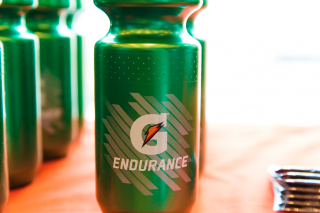
If you’ve ever run an organized race, you’ve almost certainly downed some Gatorade Endurance Formula. The ubiquitous little green paper cups line more than 300 courses around the country. Think the Boston Marathon, New York City Marathon and Chicago Marathon, as well as every Rock ‘n’ Roll Marathon Series race and Ironman triathlon.
With a lock on the on-course nutrition market, the drink is nearly unavoidable. This is great news if you’re a fan of the citrusy beverage—not so much if you (or your gastrointestinal system) find the mix too sweet to handle. As a long-time marathoner myself, I have always experienced a love-hate relationship with the drink. I enjoyed the taste and appreciated the carbs and electrolytes—but my stomach sometimes had trouble handling the mix.
RELATED: Hydration 101: Sports Drinks vs. Water
As it turns out, Gatorade was listening to the grumblings and digestive rumblings. The company’s world-class nutrition scientists had long been on the case to develop a drink that better supported athletes’ efforts and worked for every tummy.
The newly improved Gatorade Endurance Formula, released today, has no artificial flavors or sweeteners, and a much lighter flavor. During a launch event last week, I had the opportunity to taste the beverage and was truly surprised by the light, refreshing taste and the much-less-sticky mouth feel. After downing a cup and heading out on the New York City streets for a run in nearly 90-degree-heat, I experienced no issues at all.
RELATED: What are Electrolytes Good For?
So what exactly is the difference? The new Gatorade Endurance Formula has less sugar, but a similar amount of bio-available carbohydrates (22 grams)—key to performance during a 2.5-plus-hour training session or race. During long efforts, your muscles require glucose to function effectively. The body stores glucose in the liver and blood—but only a small amount. When that resource is tapped unless you feed your muscles through external sources—aka by ingesting carbohydrates. The new formula features a multi-carb (rather than single-carb) blend, which has been found to improve performance while decreasing discomfort.
Additionally, Endurance features twice the amount of sodium and three-times the level of potassium, critical electrolytes that your body loses through sweat and must be replaced to maintain optimal levels.
Expect to see the new mix on race courses staring July 22, but the powdered version of Gatorade Endurance Formula is available now online and in specialty stores in three flavors: cherry, orange and lemon-lime.
The post Whoa, Gatorade Endurance Now Tastes Totally Different appeared first on Competitor.com.
June 20, 2017
TrackTown Summer Series Brings Track To The Major-Leagues
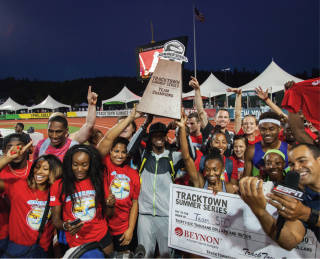
Photo: Courtesy of TrackTown USA
American track and field is aiming to become a big sport more than once every Olympic year. But to be a big sport, first it needs a big league. TrackTownUSA is building just that; the second year of its TrackTown Summer Series that starts in June.
The first meet will be held on June 29 in San Francisco, the second July 2 in Portland, Ore., and the championship July 6 in New York City, which will be televised by ESPN. What’s unique about the Summer Series, though, is the team format: Just like in other team sports, teams representing four U.S. cities will compete against each other (the three host cities mentioned above, plus Philadelphia).
According to founder and current USA Track and Field President Vin Lananna, four well-known athletes serve as general managers and select their teams of 36 athletes in a pro-style draft. (The GMs are Allyson Felix for New York City, Bernard Lagat for Portland, Sanya Richards-Ross for Philadelphia and Nick Symmonds for San Francisco.) Athletes receive contracts based on the round in which they are drafted, and can earn bonuses for winning or placing in each event, with a large bonus for the winning team.
Last year, the title was still up for grabs going into the final event—a co-ed 4x400m relay—which produced a dramatic finale, with fans and the other athletes on the infield cheering on their teammates. “Think of having a big party and plopping a track meet in the center of it,” Lananna says.
The co-ed relay isn’t the only alteration from a traditional track schedule. The list of events has been trimmed to keep the evening quick, with no races longer than the 3,000m steeplechase on the track. A 5K road race will precede the championship meet in New York City, and will also be open to the public. Amateur participants will get randomly assigned team jerseys to wear while cheering in the stands.
That arbitrary affiliation highlights the lack of any tradition or connection between the teams and their cities or the fans—as if the crowd at a Red Sox-Yankees game were randomly assigned a side to cheer for. The series has a long way to go to feel like a major-league sport, but you have to start somewhere. This is a chance to watch top athletes on the track in the United States, not the other side of the world. Team loyalty, rivalries and hometown pride will eventually come.
For more, including streaming info for the first two meets or 5K road race entry, visit Gotracktownusa.com.
RELATED: Despite Past Hurdles, Devon Allen is On Track For a Successful Season
The post TrackTown Summer Series Brings Track To The Major-Leagues appeared first on Competitor.com.
Brooks Announces Partnership With 2018 Special Olympic USA Games
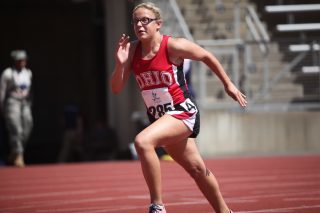
Brooks Running Company announced their partnership with the 2018 Special Olympics USA Games, taking place July 1-6 in Seattle, Wash. Over 4,000 athletes and coaches from 14 different sports will participate in the games. Also attending are over 70,000 spectators, partners and volunteers.
Brooks is hoping to bring their Run Happy spirit to the event. “The 2018 Special Olympics USA Games honors and celebrates the power of sport in people’s lives. We are thrilled to partner with an organization that shares our purpose of inspiring everyone to run and be active,” said Jim Weber, Brooks Running CEO, in a statement.
As part of the partnership, Brooks will release a limited-edition 2018 USA Games performance running shoe as well as a line of co-branded performance apparel launching in summer 2018. A portion of the sales of these products will be donated to the 2018 USA Games. Three hundred Brooks employees, partners and local running enthusiasts will serve as volunteers during the games. Finally, the company will provide a free pair of Brooks running shoes to athletes participating in the Special Olympics Healthy Athletes Fit Feet program, which offers athletes free podiatric screenings.
Pro runners Katie Mackey and Izaic Yorks, both members of the Brooks Beast Track Club, will serve as 2018 USA Games Ambassadors. Both athletes graduated from the University of Washington and have local ties to the Seattle area. The games have a special meaning to Yorks, whose sister has developmental and physical disabilities.
“Partnering with Seattle-based Brooks and its employees is an opportunity to connect them with athletes both locally and nationally,” said Beth Knox, CEO and president of the 2018 Special Olympics USA Games. “Brooks’ commitment to the community and to helping athletes prove that there are no bounds to their abilities is a terrific match for the mission of the 2018 USA Games.”
The post Brooks Announces Partnership With 2018 Special Olympic USA Games appeared first on Competitor.com.
Sara Hall and Desi Linden Will Go Head-to-Head at ASICS Half Marathon

Photo: Photorun.net
(c) Copyright 2017 Race Results Weekly(tm), all rights reserved.
A head-to-head battle between two of America’s most distinguished female marathoners, Sara Hall and Desiree Linden, will headline the ASICS Half Marathon at this year’s Gold Coast Airport Marathon on Sunday, July 2, in Queensland, Australia, organizers reported last week.
The versatile Hall, an American National Cross-Country champion who has also won the New Balance Fifth Avenue Mile, will return to the Gold Coast after placing second in the same race in 2015. Linden, a two-time Olympian and 2011 Boston Marathon second place-getter, will race on Australian soil for the first time.
“I had an incredible time in my first ASICS Half Marathon on the Gold Coast. It was magical getting to start at dark and watch the sun rise over the broadwater on the perfectly flat road,” Hall said in a statement. “The course is great for running an even effort because of how fast and flat it is. It will be my first long race in a long time, so I’m excited to see where I’m at and hopefully run a personal best time.”
The 33-year-old Linden, who holds a half-marathon personal best time of 1:10:34, said the ASICS Half Marathon was a chance to extend her marathon season after placing fourth at the Boston Marathon (2:25:06) and seventh in the United Airlines NYC Half (1:11:05) last March.
“I was looking for a good fast half marathon in mid-July. I’ve seen results from the Gold Coast over the past couple years and it’s always quick for this time of year, has great conditions and is an absolutely gorgeous course,” Linden said.
“I always feel great doing big volume weeks leading into a marathon, but rarely have a chance to taper and race shorter distances during this type of training, so I’m excited to see what type of results this will yield.”
Linden will not only line up alongside her compatriot, but she will also reacquaint herself with Rio 2016 Olympic Games Australian rivals Milly Clark and Jessica Trengove who she beat to seventh place in 2:26:08, Clark 18th in 2:30:53 and Trengove 22nd in 2:31:44.
“I was excited to see Sara’s name in the field. She’s had some great races recently and I know she’ll be looking for another quality run. She’s an incredibly tough competitor so I think we’ll really be able to push each other and hopefully we can both land some great times,” Linden said.
“The Australian women were very good in Rio and just stepped up to a whole new level with their marathon performances this spring,” Linden added.
RELATED: Patience Pays Off For Sara Hall at Friehofer’s Run for Women
The post Sara Hall and Desi Linden Will Go Head-to-Head at ASICS Half Marathon appeared first on Competitor.com.
Ryan Hall's Blog
- Ryan Hall's profile
- 21 followers



